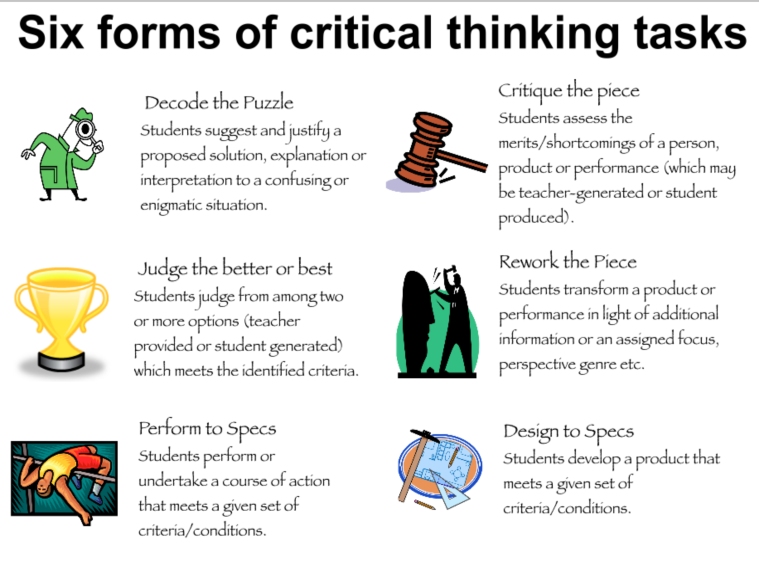If I was to investigate curricula worldwide, I would be willing to bet that critical thinking would be identified as a competency or skill that students need to demonstrate proficiency in. As noted in my previous blog post Critical Thinking Journey – Part 1, critical thinking is to make thoughtful decisions using criteria to guide one in decision-making. Critical thinking engages the student in assessing or judging the merits of “possible options” in relation to criteria or relevant factors. Thus, not only do students need to have criteria, but they also need to be assessing or judging the merits of items in relation to the criteria.
So how can we provide students with greater critical thinking opportunities?
Garfield Gini-Newman and Roland Case’s book, Creating Thinking Classrooms (which can be purchased via the Critical Thinking Consortium’s website), identifies six key strategies that an educator can use to problematize content. These authors suggest that the six strategies can work for any discipline at any grade level. Here are their strategies as follows:
| Identify the attributes of the concept | Select most relevant or important |
| Present students with a set of “yes” and “no” examples of a concept inviting them to identify the attributes shared by the yes examples, but not present in the no examples. Then present a tester example and invite students to decide whether it is an example of the concept or not. Alternatively, invite students to create a yes and no example to add to the data. | Provide students with a list of factual statements on a topic and inform students that they are to record a limited number of the statements (4 to 6 points listed). Invite students to determine, in discussion with their peers, which of the points provided are most relevant or important to the issue being studied. |
| Identify the anomaly | Decoding the Perspective |
| Invite students to identify the false statement in a list of information and justify their reasoning.
Which of these statements is least likely to be true considering the evidence in the photo? |
Present students with a short piece of text or an image and invite them to decode the perspective that is represented by using clues and drawing inferences. Encourage students to consider how someone with a different perspective might construct the image or text differently. |
| Order Events | Challenge the explanation |
| Present a list of events without dates or times provided and invite students to determine the correct order of the events based on clues, such as what people are wearing, the activities in which people are taking part. Similarly, present a series of images taken over a period of time and invite students to put the images in the correct temporal order. Invite students to sketch an image that may lie between, before, or after the set of images provided | Provide students with a possible explanation for an enigmatic or puzzling situation or phenomenon. Invite students to corroborate or refute the suggested explanation in light of available evidence and their understanding of the topic. |
In my mentorship with Garfield Gini- Newman, he has also exposed me to six forms of critical thinking tasks that the above strategies can integrate into:

One of my goals, when working with a teacher, is to embed a greater degree of critical thinking within a unit plan. Below are some examples of the tasks and strategies that I have used at teacher-team meetings or in team-teaching opportunities.
DECODING THE PUZZLE:
- Teachers were provided the photo to decode. In the sky, there was a faint outline of something in the background, which you can’t see in this upload.
- My instructions were: Develop a response to the questions at the bottom of the photo, and you must be able to provide specific evidence to justify your response.

- This task required teachers to collaborate, draw upon prior knowledge, construct meaning by drawing upon clues in the photo to justify their response, and clarify possible misconceptions.
Design to Specs:
Students in Gr. 10 Science were provided with the overarching inquiry question that was tied to the overarching critical challenge that involved designing something to meet specific criteria requirements.
Overarching Inquiry question:
To what degree can safety of an egg be enhanced by the design of an egg carrier?
Criteria for safe ride:
- Passenger is protected from variations in velocity, acceleration, and impact
- Able to remove passenger from vehicle with relative ease in a short amount of time
- Proper safety considerations are addressed: seat belt, restraints etc.
Over-arching Critical Challenge
- Design an egg carrier so that it provides the safest ride possible and prepare a scientifically sound pitch for the Manitoba Egg Board.
Criteria for “scientifically sound pitch”
- Accurate use of data to support claims
- Accurate and effective use of terminology
- Clear explanations to support claims made in the presentation of the model re: safety
Judge the better or the best:
Rank in order the contributing factors to climate change:
- driving cars
- heating homes
- cow farts
- volcanoes
- mining
- fertilizer
These are just a few examples that I have developed or borrowed from Garfield Gini-Newman’s mentorship. Over the next eight months, I will be posting different critical thinking tasks and strategies that I will be using with teachers and students.
Wishing you all a wonderful and relaxing weekend. To my American readers, Happy Thanksgiving!
Best wishes,
Ingrid




